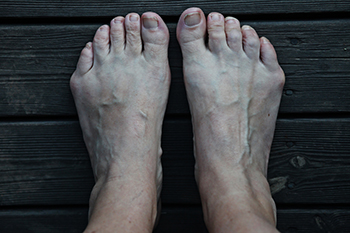 A tailor's bunion, also known as a bunionette, is a bony protrusion on the outside of the foot near the base of the little toe. This condition occurs due to the misalignment of the fifth metatarsal bone, often caused by inherited structural abnormalities, wearing tight or ill-fitting shoes, or repetitive stress on the foot. Unlike the more well-known bunion, which affects the inside of the foot at the base of the big toe, a tailor's bunion affects the outer side of the foot. Both conditions can cause pain, swelling, and redness, but a tailor's bunion specifically impacts the small toe area. To manage a tailor's bunion, wear properly fitting shoes with a wide toe box, use padding to reduce pressure, and consider orthotic inserts for better foot alignment. Non-surgical treatments, such as anti-inflammatory medications can alleviate symptoms. In severe cases, surgery may be required to correct the deformity. Proper diagnosis is essential, as tailor's bunions can be confused with other issues like hammertoes or arthritis. For an accurate diagnosis and effective treatment, it is suggested that you visit a podiatrist.
A tailor's bunion, also known as a bunionette, is a bony protrusion on the outside of the foot near the base of the little toe. This condition occurs due to the misalignment of the fifth metatarsal bone, often caused by inherited structural abnormalities, wearing tight or ill-fitting shoes, or repetitive stress on the foot. Unlike the more well-known bunion, which affects the inside of the foot at the base of the big toe, a tailor's bunion affects the outer side of the foot. Both conditions can cause pain, swelling, and redness, but a tailor's bunion specifically impacts the small toe area. To manage a tailor's bunion, wear properly fitting shoes with a wide toe box, use padding to reduce pressure, and consider orthotic inserts for better foot alignment. Non-surgical treatments, such as anti-inflammatory medications can alleviate symptoms. In severe cases, surgery may be required to correct the deformity. Proper diagnosis is essential, as tailor's bunions can be confused with other issues like hammertoes or arthritis. For an accurate diagnosis and effective treatment, it is suggested that you visit a podiatrist.
If you are suffering from bunion pain, contact Alice Kim, DPM of 101 Foot and Ankle. Our doctor can provide the care you need to keep you pain-free and on your feet.
What Is a Bunion?
Bunions are painful bony bumps that usually develop on the inside of the foot at the joint of the big toe. As the deformity increases over time, it may become painful to walk and wear shoes. Women are more likely to exacerbate existing bunions since they often wear tight, narrow shoes that shift their toes together. Bunion pain can be relieved by wearing wider shoes with enough room for the toes.
Causes
- Genetics – some people inherit feet that are more prone to bunion development
- Inflammatory Conditions - rheumatoid arthritis and polio may cause bunion development
Symptoms
- Redness and inflammation
- Pain and tenderness
- Callus or corns on the bump
- Restricted motion in the big toe
In order to diagnose your bunion, your podiatrist may ask about your medical history, symptoms, and general health. Your doctor might also order an x-ray to take a closer look at your feet. Nonsurgical treatment options include orthotics, padding, icing, changes in footwear, and medication. If nonsurgical treatments don’t alleviate your bunion pain, surgery may be necessary.
If you have any questions, please feel free to contact our office located in Camarillo, CA . We offer the newest diagnostic and treatment technologies for all your foot care needs.
